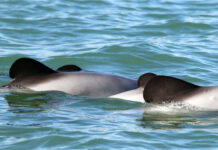
The atmosphere is changing. What is causing it – and what comes next?
Text YD Bar-Ness
The planet is undergoing unexpected and complicated – but understandable – changes. Sunlight penetrating the Earth’s atmosphere is being trapped, and the world is storing heat energy more than it used to. Why is this change occurring?
It is primarily caused by rising levels of several greenhouse gases – primarily carbon dioxide (CO2), followed by methane, which are part of the atmosphere shrouding the planet. The more of these gases (and water vapour) are in the atmosphere, the more efficiently the sun’s heat is captured.
These gases are important parts of biological systems. In fact, you – and all of the other animals on the planet – are releasing CO2 with every exhalation. We breathe in oxygen to allow us to burn sugars within our cells, and these are broken down into water and CO2 molecules. Each CO2 molecule is comprised of one carbon atom bound to two oxygen atoms, whereas water (H2O) is two hydrogen atoms bound to one oxygen atom.
Mirroring this process, but not necessarily balancing it, is the collection of CO2 by plants. Powered by sunlight, plants collect and combine CO2 with water to create the very mass of life. This includes the sugars that we break down to fuel our lives. Your body, the blades of grass, the wood of the forests, and almost all other living things are formed from that which is produced by green plants during photosynthesis.
Understanding the flow of carbon atoms through the planet is essential to understanding our changing atmosphere. Carbon is released into the atmosphere from biomass when it is broken down by fire or decomposition. You could think of our cells’ digestion of food as tiny biological ovens burning sugar. Similarly, carbon is released from biomass during forest fires or when it is broken down by fungus or other organisms.

However, the amount of carbon that is mobile within the atmosphere is only a fraction of what is actually on the planet. The element of carbon combines with other atoms to form different compounds, and only a small portion of the planet’s carbon is in the atmosphere as CO2.
More than half of the Earth’s carbon is present in rocks, such as limestone (bound to calcium and oxygen) or sandstone (primarily silicon). About a quarter is stored in the Earth’s oceans, and a miniscule portion travels into space by way of astronautics or meteors. The long and the short of it is that the rapid changes to Earth’s climate are primarily a story of vegetation clearing and the discovery of fossil energy.
The fossils and the forests
Ancient fossilised carbons are the critical piece to the puzzle: They underpin our modern civilisation and have granted us incredible reserves of energy. These fossil fuels – coal, oil, and natural gas – are the stored biomass or outgassing of biological material that has somehow been encapsulated on a vast scale.
We dig them up, burn them, and release them into the atmosphere where they act as greenhouse gases. Overall, there is probably 20 times as much carbon stored as fossil fuels than there is living plant matter on Earth. These ancient organic materials have been housed in the rocks of the Earth for millions of years. In some forms, such as coal, you can clearly identify the leaves of plants that have accumulated into coal beds.
As these materials have been brought into furnaces to power engines, and into laboratories to create new compounds such as plastic, we have extracted the energy to build the manmade world around us. When these energies are used to clear forests and drain swamps, the carbon stored in organic matter begins to decompose, or is burnt, and it finds its way into the atmosphere. That, in a nutshell, is the foundation of the current crisis.
Past changes
There is a clear correlation between levels of CO2 in the atmosphere and the fluctuations in temperature of the planet. The Earth has experienced periods of great cold and great heat in its geological past, but it has been relatively stable for almost two million years.
The climate of the last 1,000 years, and prior to the wide-scale burning of fossil fuels in the 1800s during the Industrial Revolution, has been part of a natural warming period after the most recent Ice Age.
Over the last half a million years, CO2 has shifted between 180 and 280 parts per million. Since 1950, primarily due to the burning of fossil fuels, it has skyrocketed to just over 400 parts per million, and it is not levelling out.
If this continues, we will experience a hotter climate in the years to come. We will need to find ways to either store CO2, or mitigate the greenhouse effect to avoid this uncertain, and increasingly ominous, future.
The discovery
Understanding global climate gases is built upon upon careful measurements and experimentation across disciplines including meteorology, chemistry, geology, astronomy, oceanography, botany, engineering, and physics. The Swiss naturalist de Saussure’s 1767 experiment with solar ovens led to Fourier’s 1824 realisation that the Earth could warm by sunlight’s heat energy failing to reflect back into space, developing further to produce Arrhenius’s 1859 calculations of climate change based on atmospheric gases.
Precision measurement of atmospheric CO2 began in 1958 on the peak of the Hawaiian volcano Mauna Loa; 100,000 years of ancient CO2 levels can be found in the bubbles held within Antarctic ice. Scientific inquiry into fossil life and geological events has also brought about a greater understanding of the changes in Earth’s atmosphere throughout our planet’s existence.
At daybreak, if you look towards the rising sun, you may see the bright planet Venus. Through satellite and robotic explorations of this planet, we now understand what causes the intensely hot temperatures at the surface – the greenhouse effect of carbon dioxide and water vapour. According to a recent NASA report, Venus may have once been a habitable planet, until global warming transformed the planet into its current hellish state with surface temperatures higher than 460°C, virtually no water, and an atmosphere comprised of carbon dioxide and sulphuric acid clouds.
Today, countless scientists are observing Earth’s atmospheric dynamics. While there may be a concerning number of climate change deniers, their numbers are vastly outnumbered by those who hold to the science, and by those who are suffering from its effects. The real controversy surrounding climate change is therefore not about chemistry and the science of the climate, but about responsibility and justice.
Opportunities for change
It would be too easy to become complacent, or even defeatist, in the face of these worrying changes. But there is still an opportunity for every individual to work together to set motions in place. First and foremost, we need to understand and stay alert to the problem. Only then can we give it the attention and gravity that it deserves. There’s a remarkable amount of confusion and, tragically, misinformation about climate change. For some, it’s easier to deny or ignore these changes and to resist making any tough decisions, but this is, inevitably, a losing strategy.
With that awareness comes a recognition of the pathways forward. Realising that renewable energy sources such as wind, hydro, and solar energy offer new solutions for generating power, innovative countries have invested in research and instigated infrastructure efforts towards implementing these technologies. Fossil fuels are being identified not only as non-renewable, but also as perilous, leading to increased calls for reducing reliance on these important resources.
Across the globe, people are experimenting with new methods to slow, mitigate, and adapt to climate change. While these initiatives are as yet unable to provide a capable replacement for fossil energy sources, used effectively, they may lead to a future where humanity is able to harness the tools to manage our shared atmosphere more responsibly.

Change Starts with You
When the first photograph was taken of Earth by Apollo 17 in 1972 – called The Blue Marble – humans had their first clear image of the beautiful vulnerability of our planet, orbiting silently in space. This image captures our atmosphere, and shows that it is shared by all of us. If there is one sure thing that arises from the uncertainty of a changing world, it is the singular importance of that fact. Earth is our one and only hospitable habitat – one that we won’t have the opportunity to be homesick for should we choose to lose it.
For more stories and photographs from the issue, see Asian Geographic Issue 123, 2017










